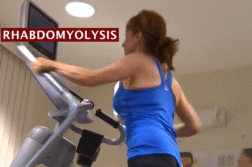BALTIMORE, Md. (Ivanhoe Newswire) — Tom Brady … Patrick Mahomes … A.J. Green … just three of the many professional football players who have struggled with turf toe, a sprain in the big toe joint. Orthopedic doctors say despite these high-profile cases, the condition isn’t exclusive to football. Turf toe hampers many sports activities for high school and college athletes, and even adult weekend warriors.
Ten years ago, Mike Greenberg never thought he’d be able to serve and volley on a tennis court again.
“So, I broke my foot dancing at a kid’s party, and it was the Michael Jackson moonwalk which actually broke my foot, as pathetic as that is,” smirked Greenberg.
That break never healed well. Time and wear and tear took a toll.
“My right big toe was flapping around,” Greenberg continued.
Doctors diagnosed Greenberg with an injury to the plantar plate of his foot … also known as turf toe. Most people associate turf toe with sports like football, soccer, and lacrosse played on artificial turf.
“The turf will kind of hold and stay intact. And as that force comes through, rather than the ground giving way, the foot eventually has to give way,” explained Patrick Maloney, MD, an orthopedic surgeon with Mercy Medical Center in Baltimore, Maryland.
Injury can happen on other surfaces. Runners, dancers, and tennis players can also struggle with the condition.
“What gets injured is the bottom supporting really strong tissue or what we call the joint capsule,” said Dr. Maloney.
Doctors say you can minimize the risk of injury. Wear shoes that provide stability, especially in the toe area. Make sure you stretch your feet so your muscles and soft tissue are less likely to be injured.
Greenberg opted for surgery to fix the injury. Six months later he started light workouts. After a year, Greenberg said he was good as new.
“And I’m like, ‘There’s no pain there. What’s going on?’ so, it’s a great feeling,” shared Greenberg.
Dr. Maloney says about 80 percent of all turf toe injuries can be managed by taping and supporting the toe or wearing a boot or other supportive shoe to keep weight off the joint.
Contributors to this news report include: Cyndy McGrath, Producer; Roque Correa, Editor; and Kirk Manson, Videographer.
KICK TURF TOE TO THE CURB
REPORT #2895
BACKGROUND: Turf toe is a sprain of the largest joint in the big toe and happens when the toe gets forcibly bent upward, much like when you push off into a sprint. This type of injury can damage any part of the plantar complex, causing mild to more severe injuries. These injuries are graded by their severity. A grade 1 injury is trauma that stretches the plantar complex which causes tenderness and minor swelling. A grade 2 injury is partial tearing of the complex that causes increased tenderness, swelling, and bruising, and becomes hard to move your toe. A grade 3 injury is considered a complete tear that causes severe tenderness, swelling, bruising, and trouble moving your big toe. Turf toe got its name because the injury became more common among football players playing on artificial turf instead of grass. Artificial turf is harder and less shock-absorbent than grass.
(Source: https://www.cedars-sinai.org/health-library/diseases-and-conditions/t/turf-toe.html)
DIAGNOSIS AND TREATMENT: For diagnosis, doctors will begin with a health history, asking about current symptoms, past medical problems, and how you injured your foot. They will check for bruising, swelling, and range of motion. Imaging often helps to diagnose turf toe, so X-rays may be ordered to make sure you don’t have any problems with your bones. To get a better look at the plantar complex, they may order an MRI. Treatment varies according to the severity of the injury. If there are only mild symptoms (like in a grade 1 injury), you might not even need to see a doctor. You can usually treat yourself by resting from the activity that caused the injury; using cold packs for 20 minutes at a time, several times a day; using an elastic compression band to help prevent additional swelling; elevating your leg to limit swelling; and taking over-the-counter pain medicine. If the injury is considered grade 2, your doctor may recommend a hard shoe or walking boot to help keep your joint immobilized for a week or so. If you have a grade 3 injury, you will probably need immobilization for several weeks, and occasionally, you may need surgery as well.
(Source: https://www.cedars-sinai.org/health-library/diseases-and-conditions/t/turf-toe.html)
BEST PRACTICES IN PLANTAR PLATE TEARS: There have been significant advances over the years in repairing the plantar plate, but correcting hammertoes with complicated metatarsophalangeal joint (MPJ) instability continues to be challenging. When correcting the MPJ, you must consider the stability of the joint, the amount of medial deviation, partial versus complete plantar plate tears, and the amount of time that has passed since complete dislocation. About 20 percent of patients will still have a floating toe at three to six months postoperatively and will require an in-office tenotomy and capsulotomy of the MPJ to reduce dorsal scarring and contracture. These procedures have proven to be very good additions in patients’ treatments. Flexor tendon transfers rarely result in a floating toe but there is a bit more stiffness. Range of motion can be more aggressive in weekly increments with physical therapy. Wrapping the toe with a Coban wrap for two to three months is essential to avoid swelling.
* For More Information, Contact:
Dan Collins, PR
Free weekly e-mail on Medical Breakthroughs from Ivanhoe. To sign up: http://www.ivanhoe.com/ftk



